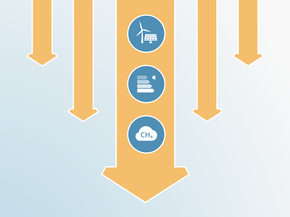Summary
Overview
Despite agreeing to pursue “carbon neutral growth” from 2020 and to set a “long-term aspirational goal of net zero carbon emissions by 2050,” the International Civil Aviation Organization (ICAO) and national governments are not taking appropriate action to reduce emissions from international aviation.
Based on ICAO’s projections, the CAT estimates that without ambitious, additional policies and actions, emissions from international aviation will more than double between 2024 and 2050 and reach approximately 1450-1700 MtCO2 by 2050. The sector remains far off track from a 1.5°C-aligned pathway and is rated as “Critically insufficient.”
The International Civil Aviation Organization (ICAO), the UN agency responsible for regulating international aviation, adopted the goal of “carbon neutral growth from 2020.” However, CO2 emissions from international aviation have increased since 2020, as the goal focuses on offsetting the sector’s CO2 emissions rather than committing to real emissions reductions.The CAT rates the ICAO’s goal of carbon neutral growth from 2020 levels as “Highly insufficient.”
Beyond its post-2020 target, the ICAO established a “long term aspirational goal of net zero carbon emissions by 2050.” However, ICAO’s plan for achieving this target is unsubstantiated. It is unclear to what extent “net zero carbon emissions” will be achieved through out-of-sector offsetting or deep in-sector reductions; for instance, via demand management, operational measures, or technological improvement. The net zero target lacks interim emission reductions targets, which means there is no clear signal for deep decarbonisation in the short or medium term. To align the sector with the Paris Agreement’s 1.5°C temperature goals, the international aviation industry needs to reduce CO2 emissions by 90% below 2019 levels by 2050 (70 MtCO2), while making deep cuts to non-CO2 emissions.
ICAO’s Committee on Aviation Environmental Protection (CAEP) developed three scenarios to inform discussions on the long-term goal. However, these scenarios lead to CO2 emission levels in a range of 70% below 2019 levels to 50% above those levels (200–950 MtCO2) by 2050; an emissions range that is well above the Paris Agreement-compatible level. The CAT would rate a net zero target within the three scenarios’ range as “2°C compatible” at best and “Critically insufficient” at worst; consistent with at least 2°C of warming, if not more than 4°C.
ICAO expects its offsetting scheme, CORSIA, to enable “carbon neutral growth” and “net zero carbon emissions.” However, CORSIA’s eligibility criteria for offsets are weak and inconsistently applied. CORSIA, as well as ICAO’s 2020 and 2050 targets, only consider CO2 emissions from the sector. CO2 emissions only account for one-third of the aviation’s overall climate impact. Indirect greenhouse gases—notably nitrous oxide (NOx) and the climate impact of contrail formation and contrail cirrus—have a combined warming effect that is greater than the direct CO2 warming effect. Efforts to reduce the climate impact from international aviation must consider the full scope of aviation’s climate effects, especially NOx emissions and minimise contrail cirrus formation.
The key industry body, the International Air Transport Association (IATA), has committed to net zero carbon from aviation by 2050. This target depends on offsetting for approximately 20% of reductions and, like ICAO’s targets, does not address non-CO2 emissions. The CAT would evaluate this target as “Insufficient” at best and “Highly insufficient” at worst.
In the absence of ambitious targets and actions by ICAO and IATA, some countries have started to address international aviation emissions themselves. However, few of the proposed strategies aim to reduce the growth of demand for aviation, which is projected to grow exponentially. Most of the strategies rely on carbon offsets, which will not neutralise the climate effects of CO2 emissions, due to offsets’ lack of permanence and fundamental concerns about additionality. Rather than accommodating the stark projected growth in aviation activity, the limited global potential for carbon dioxide removal and storage should be used to balance out residual emissions and achieve global net zero by 2050.
Just four jurisdictions are responsible for a quarter of international aviation emissions. In order of magnitude, they are the European Union, the United States, China, and the United Kingdom.
The European Union’s NDC for 2030 includes international aviation, but its climate neutrality target does not explicitly cover emissions from international aviation. Despite calls for including all outgoing flights in the EU Emissions Trading System (EU ETS) during the EU ETS reforms in 2021-2022, the EU ETS’s scope remains limited to flights within the European Economic Area (EEA) and flights from the EEA to the UK and Switzerland. The revised EU ETS Directive also introduces a requirement for aircraft operators to report on the non-CO2 effects from aviation, starting in 2025. It appears that the EU will not implement a tax on kerosene jet fuel.
The United Kingdom includes emissions from outgoing, international flights in its sixth carbon budget and will extend its 2050 net zero target to cover emissions from aviation and shipping, which is a positive development. However, the previous government’s Jet Zero strategy to bring domestic and international aviation emissions to net zero by 2050 is unambitious and insufficient; the strategy sees real CO2 emissions increase until 2050 and offsetting measures, such as the UK ETS and CORSIA, enabling reductions to “net zero.” The new government does not plan to diverge from Jet Zero’s approach, even as aviation is projected to be single largest source of the UK’s emissions in 2040.
The United States, under the Trump Administration, has reneged on the Biden Administration’s economy-wide and aviation-specific net-zero commitments for 2050. Incentives, introduced by the Biden Administration, for the production and use of sustainable aviation fuels (SAFs) remain in place, but have been weakened.
China has set targets for the reduction of emissions from airlines and airports. However, the government does not clearly distinguish between emissions from domestic and international aviation.
The CAT recommends that countries, particularly those in the Global North, start including emissions from international aviation in their NDCs and net-zero targets. The Paris Agreement requires developed countries to “undertake economy-wide absolute emissions reduction targets,” which should include international aviation emissions.
Governments should pursue a range of measures to decarbonise the aviation sector, instead of relying on out-of-sector offsetting:
- Scaling up the use of sustainable aviation fuels (SAF) to 10-15% in 2030 and 100% in 2050;
- Investing in research and development of other decarbonisation options, such as electric batteries for small aircraft;
- Operational measures, such as optimising routing, air traffic flow management, and minimising flight distances;
- Improving energy efficiency of aircraft; and
- Reducing demand for international aviation.
National governments, ICAO, and the aviation industry consider the first four measures—albeit to varying degrees—and largely disregard the demand reduction measures. However, it is highly unlikely that the aviation sector can move towards a 1.5°-compatible trajectory without reducing demand, which is expected to grow significantly until 2050.
International Civil Aviation Organization (ICAO)
| Target | Carbon neutral growth from 2020 | ||
| Coverage | CO2 only | ||
| Target | Net zero carbon by 2050 | ||
| Coverage | CO2 only | ||
International Air Transport Association (IATA)
| Target | Net zero carbon by 2050 | ||
| Coverage | CO2 only | ||
Further analysis
Latest publications
Stay informed
Subscribe to our newsletter





